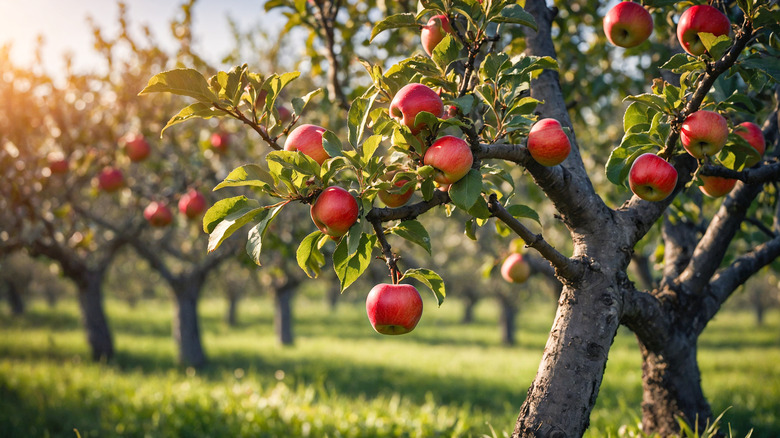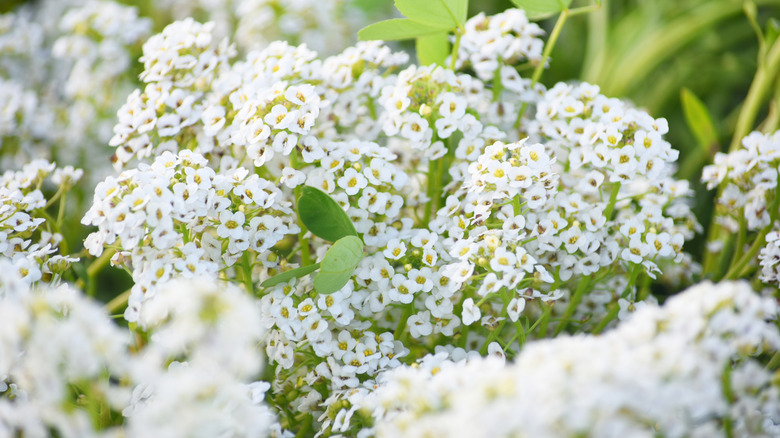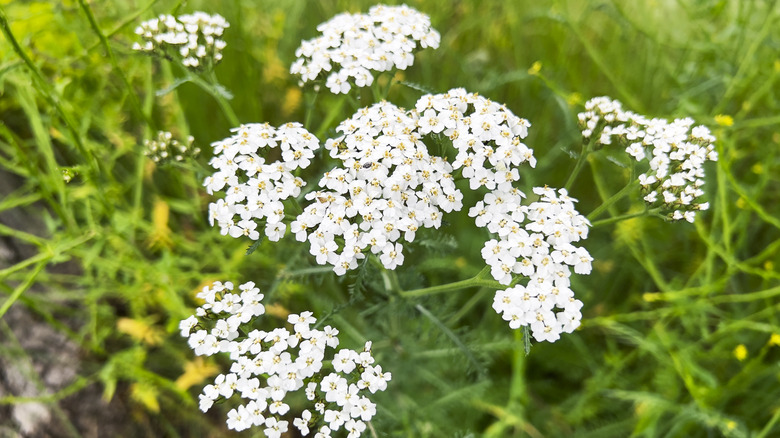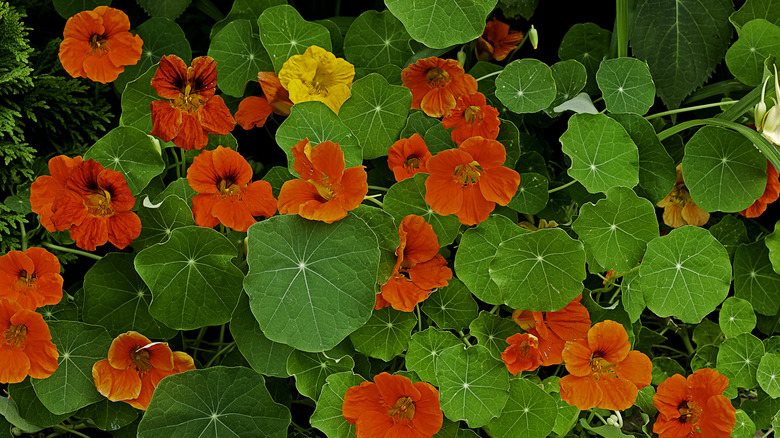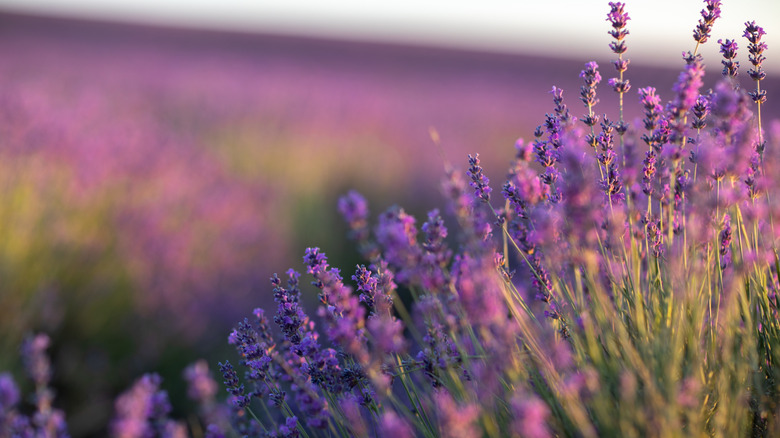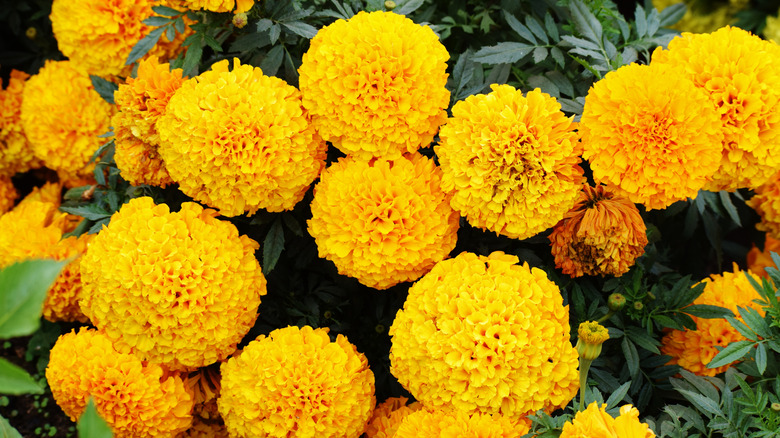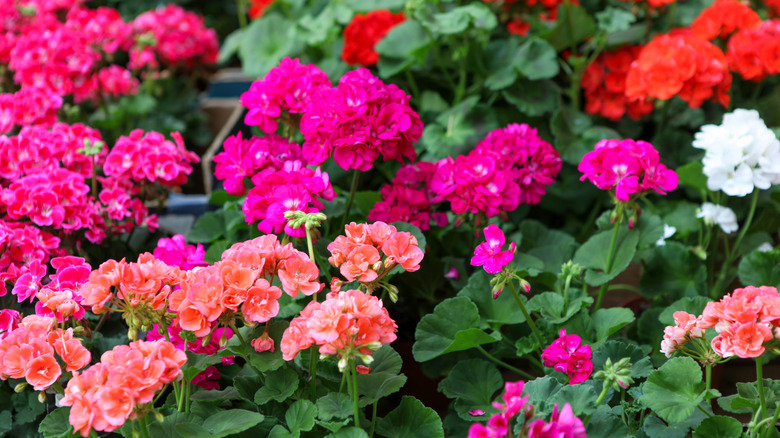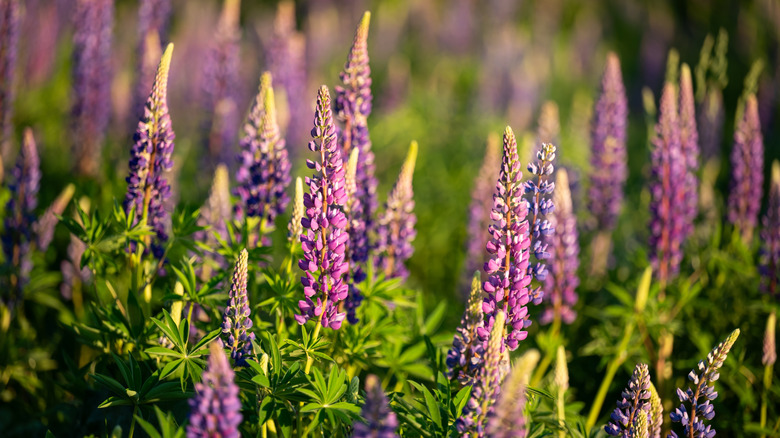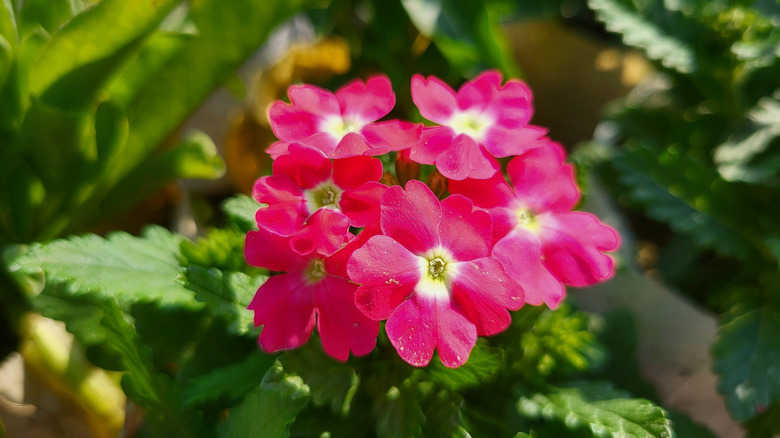The Best Companion Flowers To Plant Near Fruit Trees
When it comes to companion planting, not all gardeners and scientists agree on the practice's effectiveness. Some studies report on the benefits of growing two plants together, while others show little advantage, if any at all. Despite this, there is no harm in giving companion planting a try, especially when pairing certain flowers with fruit trees. It's important, however, that you make sure you are choosing flowering plants with growing requirements that are similar to those of fruit trees, such as sunlight needs and soil requirements. Selecting the wrong species will result in the flowers and fruit trees competing for essential resources, which could be detrimental to both.
You'll find several flowering plants are excellent companions for fruit trees, as they have the ability to enrich the soil, attract predatory insects, deter pests, and keep weeds at bay. Comfrey, for example, acts as a living mulch, shading the soil to retain moisture and suppress weeds. Tansy is another top pick, as it is known for its ability to repel harmful insects like Japanese beetles. This eliminates the need for using harmful chemical pesticides near the fruit that you're going to eat. Home gardeners can also opt for lupines, which work as nitrogen-fixing plants. They naturally enrich the soil surrounding the fruit trees. By incorporating these and other beneficial flowers, you'll be able to enjoy a bountiful harvest from your apple, pear, plum, peach, and citrus trees.
Plant sweet alyssum around citrus trees
Sweet alyssum (Lobularia maritima) is an excellent companion plant for citrus trees, offering natural pest control. Citrus trees have a serious enemy in the Asian citrus psyllid, which not only feeds on the tender new shoots of citrus trees but also spreads citrus greening disease. This disease is extremely deadly, with the USDA even referring to it as "the most serious citrus disease in the world." Since sweet alyssum has been shown in studies to attract hoverflies, whose larvae prey on these harmful insects, you'll want to plant them near your citrus trees to achieve biological pest suppression.
You'll find sweet alyssum comes in shades of white, pink, and purple and produces a pleasant scent, hence the name "sweet." When adding this flower to the landscape around your trees, you'll discover that it does quite well under the partial shade of your citrus trees, although it also tolerates full sun. Sweet alyssum grows best in USDA plant hardiness zones 5a through 9b in a well-draining soil that is kept moist. Pruning regularly by deadheading spent flowers during the summer is advised, as this will keep the plant flowering longer to continue attracting the beneficial hoverflies.
Surround fruit trees with yarrow
Yarrow (Achillea) is a powerhouse companion plant for fruit trees, offering multiple benefits that enhance the overall health of your crop. As an attractor, yarrow's clusters of tiny flowers draw in pollinators like bees and butterflies, increasing fruit set. At the same time, the flower doubles as a repeller, deterring harmful pests such as aphids and certain beetle species. Yarrow's dense foliage provides natural mulch, which suppresses weeds around your fruit trees, while also keeping the soil nice and moist. Finally, yarrow works as a dynamic accumulator, meaning it is able to draw up essential nutrients like potassium and phosphorus from deep within the soil. It stores these nutrients in its leaves and then returns the nutrients to the soil around your fruit trees when used as a natural mulch.
Caring for yarrow is a breeze, as it thrives in full sun to partial shade and well-draining soil, tolerating drought once established. This hardy perennial grows best in USDA plant hardiness zones 3a to 9b and requires little maintenance. In certain conditions, you'll find yarrow spreads rather quickly. In some areas, yarrow has a tendency to become weedy or invasive, especially in rich, moist soils. To prevent it from overtaking areas beyond your fruit trees, regularly trim back spent flowers to control self-seeding. You'll also want to divide the plants every few years. Despite yarrow's rapid growth rate, when managed properly, yarrow remains an excellent low-maintenance companion for fruit trees.
Use nasturtium to create a barrier around fruit trees
Nasturtiums (Tropaeolum) are another companion plant to consider when growing fruit trees, as they act as a natural barrier against pests. According to Washington State University, fruit growers often choose to plant nasturtiums in the root zone of their trees, believing that the fruit trees will absorb the plant's detestable scent, which then helps repel harmful insects. Although this practice has not been vetted by scientists, there are studies that confirm that nasturtiums are effective at attracting predatory insects, like ladybugs, which help control aphids and other fruit tree pests. Since growing nasturtiums near fruit trees has no impact on the taste of the fruit, it's worth giving this flower a try in your landscape.
Brightly colored showy blooms are not the only thing you'll enjoy about nasturtiums, which grow best in USDA plant hardiness zones 2a through 11b. You'll also appreciate just how easy they are to cultivate. Nasturtiums thrive in poor to moderately fertile soil, as long as the soil drains well. Although the flowers enjoy full sun, they also appreciate shade during the brighter afternoon hours. Minimal watering is required once the plant has been established, but you will want to practice deadheading, as this will encourage blooming to continue a little longer. It is important to note that nasturtiums grow quickly and can become invasive along the coast of California. If you live in this region, you'll want to take precautions to prevent the plant from spreading or forgo planting nasturtiums altogether.
Add lavender to attract pollinators
If you're searching for a plant that will provide multiple benefits for your fruit trees, consider Lavender (Lavandula). This fantastic companion plant is considered an attractor, as its fragrant purple blooms draw in popular pollinators, such as bees and butterflies. Enticing pollinators is a great way to increase fruit production. Thanks to lavender's strong scent, it also works to repel a handful of harmful insects, including aphids, whiteflies, and codling moths. Additionally, lavender serves as a suppressor, controlling weeds by shading the soil and reducing competition for the nutrients weeds need to thrive. As an added bonus, lavender adds a touch of beauty to your outdoor space.
There are a few things you'll need to know when planting lavender. It grows best for those living within USDA plant hardiness zones 5a to 9b. Lavender thrives in full and partial sun and loamy, sandy, or rocky soil, so long as water is able to drain freely. After establishment, lavender is considered low maintenance with little watering needed. In fact, if you overwater this plant, it will become susceptible to root rot and leaf spot. Spring pruning is ideal, as is cutting away any spent flowers.
Protect fruit trees from nematodes with marigolds
Dazzling onlookers with their bright yellow or orange blooms, marigolds (Tagetes) are a top choice when it comes to planning a companion plant for your fruit trees. This flower not only attracts bees and butterflies for improved fruit production, but it also emits a strong odor that works to repel common fruit tree pests, like aphids and whiteflies. Just like yarrow, marigolds serve as dynamic accumulators, ensuring fruit trees get maximum nutrients. Finally, marigolds keep harmful nematodes from attacking nearby fruit trees. Not all marigold varieties are equally effective, however. Signet marigolds (T. signata pumila) have been reported to provide little to no nematode control, so it's best to go with French or African marigolds, as they have been shown to be among the most reliable.
Marigolds are low-maintenance flowers that grow best in USDA plant hardiness zones 2a through 11b. Although they prefer full sun for more vibrant blooms, you'll find marigolds can live in a wide range of soil types, as well as in soil that is acidic, neutral, or alkaline. The soil must drain well, however, and remain moist, drying out only once in a while. To keep marigolds blooming so that they continue to attract pollinators, you'll need to practice deadheading during the growing season.
Grow geraniums to keep Japanese beetles off fruit trees
If you plan on growing apples, cherries, peaches, or plums, you'll want to add geraniums (Geranium carolinianum) to your garden. These particular fruit trees are extremely susceptible to Japanese beetles, which are invasive and known to cause damage in large numbers. Geraniums are not only beautiful to behold but also offer protection from these dangerous pests. Studies have shown that after feeding on geranium leaves, Japanese beetles experience a temporary paralysis, making them more vulnerable to predators. They also become easier to remove by hand, after which you can place them in a bowl of insecticidal soap for full control. When you take advantage of the natural effects of geraniums on Japanese beetles, you reduce beetle population without having to use chemical pesticides around your growing fruit.
Best grown in USDA plant hardiness zones 9a through 11b, geraniums are another low-maintenance plant that can handle both full sun and partial shade. They grow well in clay, sand, and rocky soils with an alkaline or neutral pH. The soil must be well-draining and allowed to dry out occasionally in between waterings. Just like with other showy flowers, geraniums continue to bloom when regular deadheading of spent flowers is performed. At the end of the summer, you can choose to overwinter the geraniums indoors in a set of flowerpots.
Add lupine to create a nitrogen-rich soil for fruit trees
Lupines (Lupinus) have showy blooms in a variety of striking colors, but it is the flower's ability to attract pollinators and fix nitrogen levels that makes it the perfect companion plant for fruit trees. As attractors, lupines draw bees, hummingbirds, and butterflies to the area, improving pollination and fruit set. The plant is also able to convert nitrogen gas from the air into nitrogen that can then be used by the plants to produce a more fertile soil that benefits nearby fruit trees. Trends in Agricultural Sciences even reported on a study that looked at the effects of intercropping lupines with citrus trees. The results showed that this practice significantly increased orchard productivity, further solidifying lupines as companion plants for fruit trees.
Growing and caring for a lupine plant isn't as hard as you may think. You simply need to provide full sun or partial shade and make sure the soil is well draining with an acidic pH. This companion plant is ideal for those who live in USDA plant hardiness zones 4a through 8b. Seeds should be planted in the fall and once the lupines are established, their roots will reach deep into the soil – making them drought tolerant. Only minimal watering is required during the growing season. Finally, regular deadheading of spent flowers can encourage prolonged blooming and prevent unwanted self-seeding.
Plant verbena to keep pests away from fruit trees
When it comes to valuable companion plants for your fruit trees, verbena (Verbena canadensis) should definitely be on your list. This lavender-colored flower is able to attract such beneficial insects as syrphid flies, soldier beetles, leafcutter bees, thynnid wasps, and hoverflies. You'll find syrphid flies control aphids, while soldier beetles target both aphids and caterpillars. Thynnid wasps are known to aid in controlling Japanese beetles, and hoverflies take care of pesky Asian citrus psyllids for home citrus growers. Pollinators, such as bees, hummingbirds, and butterflies are also drawn to verbena, which we discovered benefits fruit production. When utilizing these biological pest control methods, the need for chemical control within the orchard is diminished.
USDA plant hardiness zones 6a through 10b are best for growing verbena. The plant isn't picky and will do well in both full sun and partial shade, as well as in soil that is sandy, loamy, rocky, or made of clay. You will need to make sure the soil drains well, however, and that it stays moist, drying out only occasionally. Gardeners should be aware that certain species of verbena, like Verbena bonariensis, Verbena montevidensis, and Verbena incompta for example, are considered invasive in California and across the southeastern United States. Gardeners in these regions should exercise caution and consider native alternatives to prevent unintended spread.
